Atlantic Monthly Contributors's Blog, page 414
June 14, 2015
Building for the Future, in California's Famously Failed City
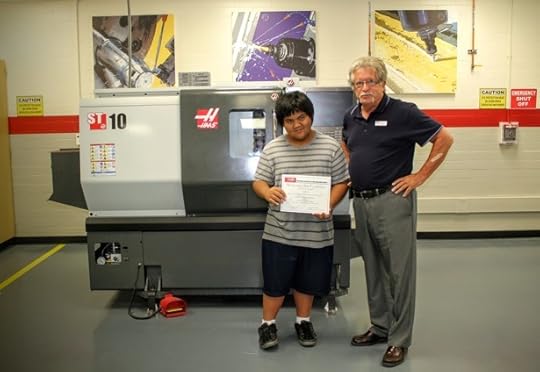
Today’s Los Angeles Times has a big take-out by Joe Mozingo, with photos by Francine Orr and extensive online graphics, about the ongoing woes of San Bernardino, California. The city’s problems, as we’ve set out in previous installments, have been a heartbreaking vicious-cycle combination of economic misfortune worsened by political dysfunction. Over the past generation, San Bernardino has lost every one of its traditional big sources of blue-collar employment: a steel mill, a railroad yard, the commerce related to a major Interstate (before it was relocated 15 miles west), and then an enormous Air Force base.
 The people, organizations, and ideas reshaping the country
The people, organizations, and ideas reshaping the countryRead More
We’ve been to other cities that have endured nearly comparable business-loss blows and have found ways to adapt and recover. What made San Bernardino’s problems so much worse was its uniquely paralyzed form of city government, which had a classic “failed-state” effect.
As the city’s people grew poorer, their dwindling resources were increasingly funneled to a small class of politically favored interest groups. In San Bernardino’s case, those were mainly the police and fire-fighter unions—nearly all of whose members lived in other, “nicer” cities and who became among the best-paid public employees in the state even as the city was becoming the most impoverished. The LAT piece points out that even as median household income in the city was sinking below $40,000, median pay for firefighters was rising above $150,000.
I’ll leave the structural problems there for the moment. For more, please do read the LAT feature, which includes accounts of many of the city’s left-behinds; or follow the city-in-crisis reporting of Ryan Hagen in the San Bernardino Sun; or see the city’s official Plan of Adjustment for pulling itself out of bankruptcy; or see the 2014 analysis by the consulting firm Management Partners about the roots of the city’s problems and an earlier Vision Statement, or this analysis from George Mason University. Plus our articles “What It’s Like When Your City Goes Broke,” “Today a Bankrupt City Votes on Its Next Steps,” “Steps in Civic Life,” and the first half of this post, on why the real divide in California is not north versus south but rather coastal California versus the inland areas.
***
I mentioned several posts ago that San Bernardino’s problems are so well chronicled that from this point on we’re going to focus on people who are trying to do something about them. Thus we’ve told the stories of “Generation Now,” a young-people’s organization trying to make San Bernardino’s residents feel like citizens; the AVID program at a local which school, which “saves lives one at a time”; crusading former mayor Pat Morris; and current school board president Mike Gallo, an aerospace entrepreneur who now dedicates his considerable energies to improving life prospects for the mainly poor, mainly non-white students in his adopted city’s public schools.
Today’s installment: a look at Dr. Bill Clarke and the multi-tier educational program of which he is part. This program is designed to retrain adults in the area who have been left out of the work force (most residents of San Bernardino are on some form of public assistance), and to prepare younger ones to get and hold high-paying jobs.
***
Bill Clarke grew up in Boomer-era Southern California in a non-college family. “My dad told me that I had to get a degree, and that I should get a job I really loved,” Clarke told me last month. “I was fortunate enough to do both.” From the mid-1970s through the late 1980s he worked for General Dynamics in Pomona, as a manager and trainer in their advanced-automation divisions. In the late 1980s, while beginning work on a doctorate in educational management, he switched to the local community college, San Bernardino Valley College, where he headed their training departments for advanced manufacturing and welding. And through all those years, 1974 through 2008, he spent the mornings teaching at Fontana High School in their manufacturing-skills courses.
These were the years when, with some ups and downs, Southern California was still generally booming, and the skills Clarke taught prepared students for higher-wage factory and construction jobs. But also during those years, “vocational education” and trade schools were falling out of public fashion, because of the conceit that white collar positions automatically meant brighter prospects and better pay. (Why I call it a “conceit”: the past decade has brought a reminder that skilled technical positions — in maintenance and repair of advanced machinery, in health-care fields or other laboratory work, in agricultural or food technology, in logistics and construction — are the era’s fastest-growing “good” jobs.)
By 2010, San Bernardino Valley College had decided to phase out the machine shop Clarke and been running, and he was ready to retire from his teaching role there as he had earlier retired from the Fontana public schools. By that time he had become friends with Mike Gallo, the aerospace entrepreneur whose Kelly Space Technology is the city’s leading tech firm. “Mike said, ‘Why don’t you bring your equipment over to my place and teach here?’” Clarke told me. “I said, I don’t want to teach any more. And then he said, ‘Well, what if we started your own school?’”
The result (skipping past some other details) is Technical Employment Training Inc. (TET), a non-profit, 501(c)(3) trade school for adults that now operates in a building at the former Norton Air Force Base, now San Bernardino International Airport. Gallo is its CEO; Clarke is its president; and its ambition is to train the city’s now-unemployed adults for middle-wage jobs available in the area’s hospitals, warehouses, light factories, and construction sites.
 Sign outside the TET headquarters
Sign outside the TET headquarters The non-profit aspect of TET is important. When I spoke with Gallo this spring, he inveighed against some for-profit trade schools as representing the worst in the student-debt syndrome. (They deserved more blame, he said, because they loaded debt onto mainly disadvantaged students, without carefully matching them to available jobs.) And Gallo and Clarke both emphasized the four-part strategy on which their TET approach was based:
• A “comprehensive, immersive training environment,” in which students work in a machine shop six hours a day, five days a week, for six months.
• Nationally recognized credentials and certificates at the end of the program, so that their training is officially recognized and is transportable.
• A realistic, on-the-job training environment, in which students produce real products on real machinery and thus can go to employers with real-world experience.
• Placement connections with local employers, of whom the region’s fastest-growing at the moment are in health-care and logistics. (San Bernardino, as I’ll explain in one more installment, figures that its main comparative advantage is as a warehouse site for the huge Southern California economy.)
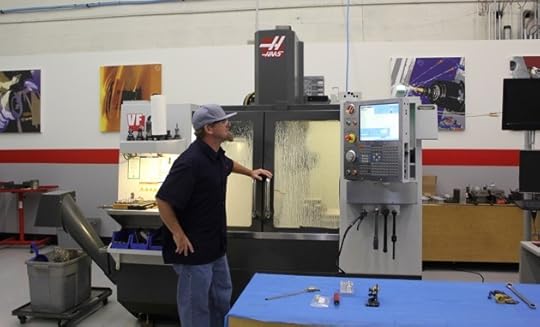 A TET instructor demonstrating a Haas machine tool like those in advanced-manufacturing shops
A TET instructor demonstrating a Haas machine tool like those in advanced-manufacturing shops I realize that most multi-point plans sound platitudinous. But TET’s approach resembles strategies we’ve seen work elsewhere: for instance, the one at East Mississippi Community College. Nearly 400 local people have completed the full program program at TET, Clarke said: “And we have put most of our graduates back to work in the high-tech manufacturing world. There are thousands of these high-tech jobs out there. We cannot train people fast enough for them.”
***
TET is designed for adults who have already run into problems in the modern working world. Meanwhile Gallo (as president of the school board), Clarke, and their allies are launching a parallel effort to prepare the city’s school children to be ahead of the game.
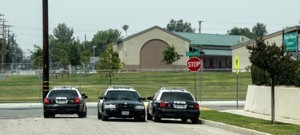 Nearing Norton elementary school
Nearing Norton elementary school Bill Clarke took me to see what this meant, in practice, at two public schools that would normally be classified as “troubled” or “have-not” in political discussions. As we drove up to Captain Leland Norton Elementary School (“Home of the Aviators”), we passed three police cars on patrol. There and at nearby Indian Springs High School (“Home of the Coyotes,” where a large team of security officers was biking around the campus), virtually all students arrive with financial, educational, linguistic, and other family-background challenges.
But these are the places where the San Bernardino school system has made a commitment to training students for skilled-technical jobs. (For similar efforts we’ve seen elsewhere, check Deb Fallows’s story about the “Elementary School for Engineering” in South Carolina, John Tierney’s on the Maine Maritime Academy, and mine about the “Career Technical Academies” at Camden County High School in Georgia. Plus see this NYT article on a related effort in New York.)
In elementary school, this means lots of training in digital tools. Mike Gallo sent me a picture of a Norton third-grader showing him the SolidWorks 3-D design program:
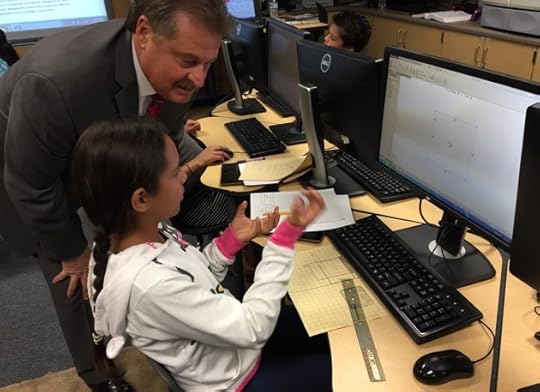 Mike Gallo and a Norton Elementary school third-grader
Mike Gallo and a Norton Elementary school third-grader Gallo added in an email:
This is the EXACT same program my rocket scientists use to develop the latest rocket test systems for NASA’s space shuttle replacement vehicle.
This is the student engagement environment and culture of high expectations that our students are now able to experience. This will transform San Bernardino and provide them with the passport to prosperity!
At Norton I also saw a news broadcast entirely planned, reported, produced, narrated, and distributed by teacher Beverly Sayson’s students. Among other tools they used the green-screen in this studio:

Sayson also showed off some of the toys, precision parts, blocks, and so on that the students had made with the 3-D printers in their classroom.
Let me take a moment again to say that these are students from poor and poorly educated families, in a chronically low-ranked school system, where they are being engaged rather than warehoused or ignored.
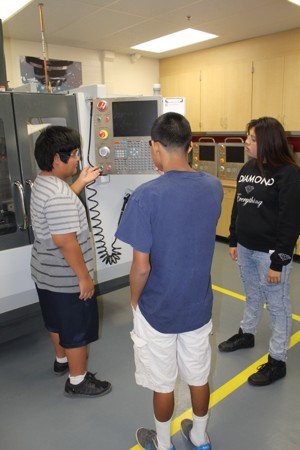 Indian Spring 9th grader Frank Le demoing computerized machine tool to other students
Indian Spring 9th grader Frank Le demoing computerized machine tool to other students At Indian Springs High School, Clarke showed me a fully outfitted machine-tool work shop, in which students are trained and then certified for highly-skilled trades. The photo at the top of this page was a recognition of one 14-year old for completing a high-level machine-tool course.
“We’ve built our elementary school lab, and middle school, and high school, so that soon students here will have a genuine pathway,” Clarke told me. “By 2017, all 17,000 students in all San Bernardino schools will leave one of our nine high schools with real-world credential in a growth-demand sector.” These sectors, according to Clarke, include health care and medical technology (strong in the region), logistics and transportation (ditto), and manufacturing. This model — giving all students a “normal” education, but also equipping them with technical skills — is one we’ve seen in action elsewhere and have come to respect.
***
Can any of this happen? Are the odds too stiff? I don’t know. By itself will it solve San Bernardino’s problems? Certainly not.
But after spending time with people like these and in their classrooms and with their students, I do know two things. One is that the school system is now moving forward rather than back, as suggested by the charts below. The other is that in a famously “failed city” with a long-struggling school system, people are working hard to give others a better chance.
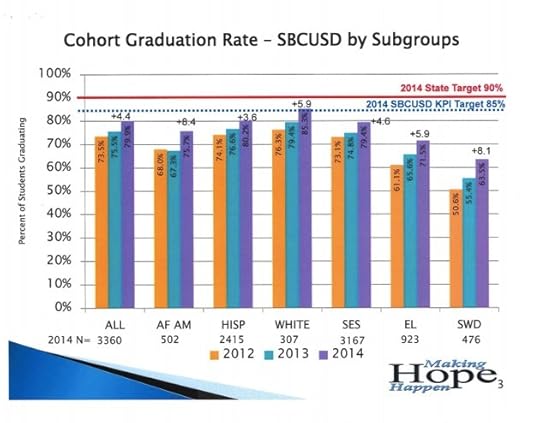 Graduation rates for San Bernardino Schools, 2012-2014. The columns, from left, are for: all students, African-American students, Hispanic students, white students, students from lower socioeconomic status, students who are “English Learners” (non-native speakers), and students with disabilities. Courtesy Mike Gallo.
Graduation rates for San Bernardino Schools, 2012-2014. The columns, from left, are for: all students, African-American students, Hispanic students, white students, students from lower socioeconomic status, students who are “English Learners” (non-native speakers), and students with disabilities. Courtesy Mike Gallo. 








Jurassic World Breaks the 'Box Office Sound Barrier'
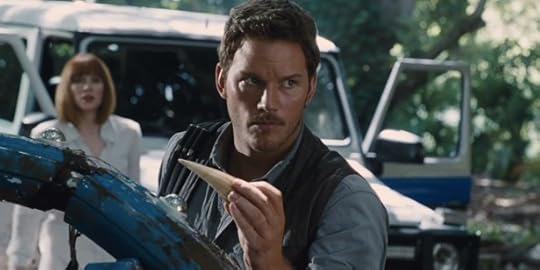
What do you get when you cross early 90s nostalgia, a “super-dino more terrifying than any to walk the Earth before it,” and Millennial star power? The immediate answer seems to be about half-a-billion dollars.
Jurassic World, despite lukewarm-to-warm reviews, pulled off the highest-grossing global opening of all time with a $511.8 million haul this weekend. "This over-performed in a way that I've never seen," one box office analyst told the AP. "It broke the box office sound barrier."
The Chris Pratt-led flick’s domestic gross is also estimated to be $204.6 million, which would make it the second-best domestic opening behind only The Avengers in 2012. Depending on how many Americans resist the NBA Finals in favor of the movie theaters on Sunday night, the dinosaur thriller could break that record too. All this for a film that was expected to peak domestically at $130 million in its first weekend.
So how did Jurassic World do it? First things first, it pulled a fifth ($100 million) of its total ticket sales from China. It also scored big by luring moviegoers to pay more to see it in enhanced formats. “The sequel took in 48 percent of its domestic opening weekend receipts from 3D screens,” Variety noted, “while setting new high-water marks for Imax and private label PLF [premium large format] screens.”
It also had no competition. With no other movies debuting this weekend, Jurassic World crushed its nearest domestic competitor—Melissa McCarthy’s Spy in its second weekend—by nearly $190 million.
While the superhuman showing provides some relief for an industry that was suffering through a sluggish summer opening, you’ll likely catch celluloid purists rolling a collective eye at the results. “The performance is a boon to Universal, and to actor Chris Pratt’s burgeoning career as an action star,” writes Max Nisen at Quartz. “But it may only reinforce Hollywood’s obsession with sequels and established franchises over new stories.”
To that point, Chris Pratt, the film’s leading man, was asked earlier this week if he had signed on for a sequel yet. His response: “They have me for I think 38 movies or something.”









Clinton Comes Out Swinging
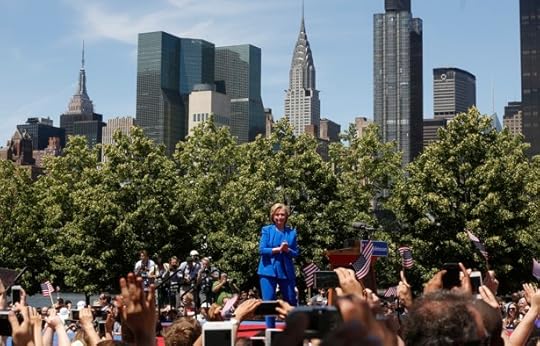
Compared to most presidential announcement speeches, Hillary Clinton’s in New York Saturday was certainly unusually long. She spoke almost 12 minutes longer than her husband in 1991; more than 15 minutes longer than Al Gore in 1999; almost twice as long as Barack Obama in 2007.
Compared to the announcement speeches of her predecessors, Clinton also skimped on the acknowledgements of her beloved spouse. There was no equivalent of Bill’s, “I want to thank…Hillary for being my wife and friend and partner, for the love we’ve shared, and the work she’s done to make life better for children and families of this state and this country…” Nor did she bother with the “all praise and honor to God” that opened Barack Obama’s announcement. In other words: points to Clinton for sincerity.
On the other hand, the highly detailed policy message of her announcement was not unique. In that regard, her announcement followed the examples of Clinton, Gore, and John Kerry, too—although the heft and specificity of her policy detail far exceeded theirs. It was Obama’s grand thematic style that was exceptional among recent Democratic announcements.
Related Story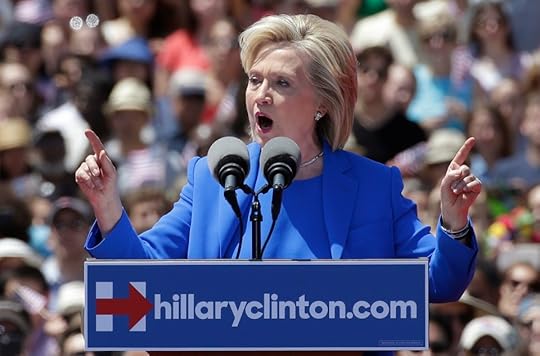
Democrats thrilled to Obama’s announcement speech at the time. In retrospect, however, its message doesn’t stand up so well: America’s divisions are illusory, concocted out of nothing by shadowy interests to fragment a fundamentally united people. The way to overcome those divisions? Leadership. "What's stopped us from meeting these challenges is not the absence of sound policies and sensible plans. What's stopped us is the failure of leadership.” (Obama’s more liberal supporters now deride journalists who ask, “Why won’t Obama lead?” But Obama himself defined the issue in exactly that way.)
But if it was ever unclear, it’s a lot clearer in 2015 that the divisions in U.S. politics are not caused by misperceptions. American politics is shaped by three great facts:
1. The slowness of economic growth in the past decade and a half—punctuated in middle by the shock of the Great Recession—has depressed the material resources available to American society at exactly the time when
2. The baby-boom generation has begun to claim retirement benefits from younger cohorts that have grown up during more difficult economic times, despite
3. Multiplying ethnic, racial, and cultural diversity that promotes every battle over income distribution into a culture war, as well.
Hillary Clinton may praise Barack Obama, but she delivered a stinging criticism of his approach to the presidency.“Leadership” can’t overcome the arithmetic that says today’s slow-growing U.S. economy cannot afford to preserve the tax rates of the 1980s and 1990s and sustain Social Security and Medicare in their present form and offer health coverage, child care, and cheap college tuition to people in their 20s and 30s.
“Leadership” can’t stop each American subgroup from noticing that their competitors in the fiscal competition look different, come from different places, and live in different ways.
Hillary Clinton may praise Barack Obama, but her message delivered a stinging criticism of his approach to the presidency—a criticism that her party is ready to hear. Her repeated emphasis on “fighting” effectively proclaims: Yes, we are divided. I am dispensing with the feel-good talk. The other side is battling for their team: older, whiter, more affluent, more married, and more rural. I’ll battle just as hard for my team: younger, more diverse, less affluent, unmarried, and more urban. A vote for me isn’t a vote for ‘unity.’ It’s a vote to claim a larger piece of the nation’s dwindling resources from people you don’t like and who don’t like you. They don’t like me either, but following Franklin Delano Roosevelt, rather than my oversensitive former boss, I don’t care.
Hillary Clinton’s speech had to be long because the coalition she seeks to assemble is made up of so many different sub-units, each of which needed to be assured that its claim would be included in the total: unauthorized immigrants, indebted college students, working mothers … schoolteachers …Obamacare enrollees …: a coalition of interest groups who may not always recognize each other as allies and who cannot automatically be relied upon to show up on voting day.
Clinton is frankly presenting herself as a politician of inter-class struggle.Very strikingly, the speech contained no mention of either Social Security or Medicare. In four separate places, the speech criticized as insufficient the taxes paid by wealthy people. It offered only the most glancing reference to farmers. These are the groups from whom much must be required in order that to others, much might be given. Despite her own great personal wealth, and long association with people even wealthier than herself, Clinton is frankly presenting herself as a politician of inter-class struggle.
Clinton did leave open a door for some allies from the other side of the barricades. She made clear, however, that their entry into her coalition depends upon their acceptance of her terms, not her acceptance of theirs: “There are public officials who know Americans need a better deal. Business leaders who want higher pay for employees, equal pay for women and no discrimination against the LGBT community either. There are leaders of finance who want less short-term trading and more long-term investing.” She promised soon to unveil policies to “reward businesses who invest in long term value rather than the quick buck.”
But the rewards are conditional on good behavior. Her disapproving eye falls severely on the "financial industry and many multi-national corporations have created huge wealth for a few by focusing too much on short-term profit and too little on long-term value ... too much on complex trading schemes and stock buybacks, too little on investments in new businesses, jobs, and fair compensation.”
Again, much of this has been heard before. Her line, “America succeeds when you succeed,” echoes a line in John Kerry’s announcement in 2004. (“If Americans aren’t working, America’s not working.”) What is new this time is not what is said, but who is saying it: a politician who self-advertises as the toughest, fiercest, most relentless fighter Democrats have seen in a very long time. Some people (you know who they are) might imagine leadership as inspirational rhetoric and necessary compromise. Hillary Clinton disagrees. “Leadership means perseverance and hard choices. You have to push through the setbacks and disappointments and keep at it.”
In 2007, Barack Obama again and again referenced hope. Hillary Clinton did not use the word once. What she repeatedly offered instead is fighting, and lots of it. On this, at least, she seems likely to keep her word.









'Hello Earth! Can You Hear Me?'
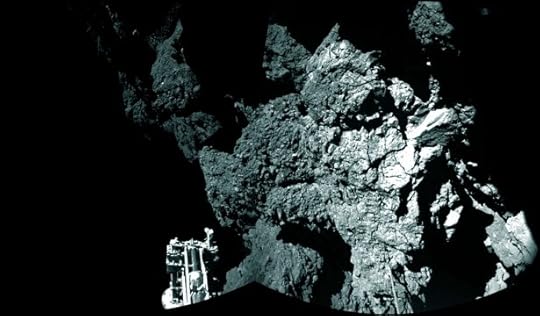
Philae, the washing-machine-sized robot that landed on a comet late last year, awoke this weekend from a months-long hibernation and surprised scientists with a transmission from outer space. A Twitter account affiliated with the project tweeted the good news.
Hello Earth! Can you hear me? #WakeUpPhilae
— Philae Lander (@Philae2014) June 14, 2015
Philae spent 10 years in space before detaching from the Rosetta spacecraft and successfully landing on a comet in November. The lander's mission was to report back to Rosetta—and, by extension, scientists on Earth—about the composition of its new comet home. But Philae's first battery pack ran out about 60 hours after landing, and a rougher than planned bounce-landing made it unclear—until now—whether the robot ended up in a spot that would receive enough sunlight for a second, solar-powered battery pack to recharge Philae back to life.
“Philae is doing very well,” wrote Stephan Ulamec, a Philae project manager, in a blog post for the European Space Agency. More from the ESA blog:
Rosetta’s lander Philae is out of hibernation! ... For 85 seconds Philae “spoke” with its team on ground, via Rosetta, in the first contact since going into hibernation in November.
Now the scientists are waiting for the next contact. There are still more than 8,000 data packets in Philae’s mass memory which will give the DLR team information on what happened to the lander in the past few days on Comet 67P/Churyumov-Gerasimenko.
Now that Philae is awake, scientists hope to learn more about the shape, density, temperature, and chemical make-up of the comet. They'll also analyze the comet reacts to cosmic dust and solar wind.
The origins of Philae’s name are perhaps as lofty as its goals. It is an homage, ESA says, to an obelisk found on the island of Philae, in the Nile region of Egypt, that held the final clues for deciphering the hieroglyphs on the Rosetta Stone—the hunk of inscribed rock that unlocked human’s modern understanding of ancient texts and symbols.
“No one knows,” the ESA says, “precisely how long the lander will survive on the comet.”









Is Sepp Blatter Staying?
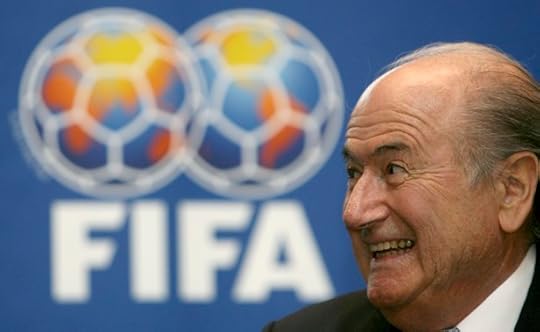
Stop me if you’ve heard this one: The FIFA president, secretary general, and media director are sitting in a car. Who's driving? (Answer: The Police.)
It was this joke, told on Swiss television last week by Walter de Gregorio, FIFA's own director of communications, that resulted in de Gregorio’s forced resignation. Something about this seems unjust. If anyone in the FIFA kingdom should be afforded a little room to make a pointed barb, it’s an official whose recent duties involved standing before the press again and again as one of the most sweeping scandals in sports history unfolded.
But the truth is that no one really tells a joke like that unless he or she is angling to be fired. According to a Swiss newspaper, de Gregorio’s sudden departure coincides with a report that FIFA Chief Sepp Blatter, who announced his resignation earlier this month, is now reconsidering his decision. This makes sense; de Gregorio had advocated for Blatter’s immediate departure and Blatter, who isn’t slated to be replaced until December at the earliest, has a history of saying he was finished and changing his mind.
“Blatter did promise in 2011 that he would quit as president in 2015 only to renege on that vow,” The Telegraph noted, “and his critics are suspicious his resignation speech may have been designed to buy him time to remain in office.”
After winning a fifth term as FIFA president late last month, the 79-year-old executive also promised this term would be his last. Days after Blatter announced his imminent resignation, former FIFA governance adviser Michael Hershman told ESPN’s Jeremy Schaap that he didn’t totally believe that Blatter would walk away.
So what’s got Blatter rethinking things? According to Schweiz am Sonntag, messages of support from Asian and African football associations—the very constituencies that enabled his controversial reelection—are said to have gotten to him.
Blatter has a tough road ahead of him. On Sunday, at least one FIFA executive, Domenico Scala, who heads the organization’s audit and compliance unit, told The Irish Times that Blatter needs to stick to his words.
For me, the reforms are the central topic. That is why I think it is clearly indispensable to follow through with the initiated process of president’s change as it has been announced.
Meanwhile, EU lawmakers have been pressing for Blatter to step aside now rather than later.
Blatter may be banking on enough time passing for the scandal to recede from the public consciousness so that he may once again consolidate his power. After 17 years of FIFA rule, he probably shouldn’t be underestimated.









Silicon Valley’s Brutally Funny Indictment of the Tech Industry
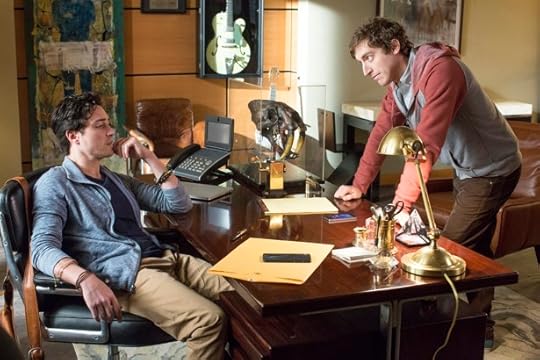
In the penultimate episode of Silicon Valley’s second season, the Internet start-up Pied Piper finally got its big break. The company’s video-compression software had been boxed out at every turn by its moneyed competitors, and its one contract, a live-stream of a nest of condor eggs, had attracted no viewers. That is, until a museum worker arrived to remove an unhatched egg, fell, and grievously wounded himself on-camera, instantly turning the live-stream into a worldwide online event. Silicon Valley, which ends its second season Sunday, is a comedy first, but a dark indictment of an industry as a close second—one that never lets its viewers take for granted why they’re laughing.
Related Story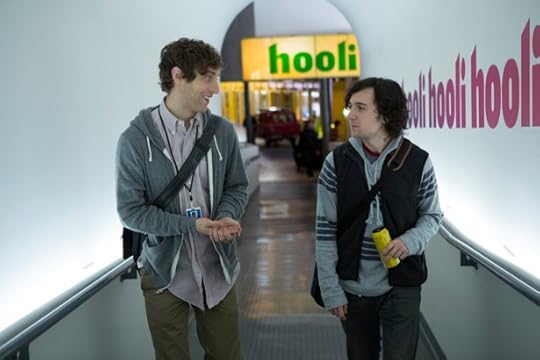
Revenge on the Nerds: Why It's So Cool to Laugh at the Tech World Now
The cleverest thing about Silicon Valley’s satire is that the show presents its central plot as a seemingly straightforward story arc: the path of shy, nervous programmer Richard Hendricks (Thomas Middleditch) to start-up superstardom after he creates an algorithm that compresses data with revolutionary ease. Mike Judge’s comedy seems to be taking the audience through the various stages of a nascent tech company’s growth in the Bay Area, from initial venture-capital investments to large-scale hiring. But in Silicon Valley’s second season, Richard’s journey has become a Sisyphean struggle against an evil conglomerate hell bent on blocking him at every turn, and nearly every episode contains a plot twist that turns Richard’s small triumphs against him, whittling his idealism down to nothing.
To recap: This year, Pied Piper attracted handsome investment offers from many venture-capital firms, all of which were withdrawn when the evil tech giant Hooli (clearly modeled on Google and/or Apple) sued the start-up for copyright infringement. So Richard turned to the unstable, self-made billionaire Russ Hanneman (Chris Diamantopoulos) for funding, but his meddling only added to Pied Piper’s bad reputation around town. Then another company ripped off Richard’s algorithm. Then Pied Piper lost a chance to win a big contract when Russ rested a bottle of tequila on someone’s delete key during a coding session. Then Hooli won its lawsuit against Pied Piper because Richard tested his software one time on a company computer. And finally, he got his big break—but only because someone might die on camera on one of his live-streams in the finale.
Again, this is supposed to be a comedy. Silicon Valley mines laughs from its well-drawn characters, like the stoned, pigheaded entrepreneur Erlich (T.J. Miller) or the reserved, polite-to-a-fault business adviser Jared (Zach Woods). But like all of Mike Judge’s best work (the film Office Space, or the TV series King of the Hill), the one-liners are just momentary distractions from the creeping truth that the world is a cruel place where only the most ruthless can truly succeed.
Silicon Valley’s approach to plotting can make for a frustrating viewing experience. The Pied Piper programmers typically insult each other and goof off for 25 minutes before another devastating twist arrives. Part of the reason for this is surely that everyone on the show is a coder, and the writers sees little dramatic potential in their simply doing their jobs. There’s admittedly not much excitement to be found in watching someone tap furiously at a keyboard, but the nerdy testosterone thrown around by programmers Bertram (Martin Starr) and Dinesh (Kumail Nanjiani) proves to be an amusing substitute.
“I don’t want to live in a world where somebody else makes the world a better place than we do,” the Hooli CEO tells his executive board.Even funnier are the show’s glimpses into the internal politics of Hooli, a replication of those geeky programmer wars on a CEO scale. The company’s preening founder Gavin Belson (Matt Ross) wants Pied Piper destroyed not just because it could be a potential rival, but because Richard made the unthinkable choice of refusing his corporate oversight. “I don’t want to live in a world where someone else makes the world a better place than we do,” he tells his executive board in a tone of utmost seriousness.
Richard’s sad but noble choice was trying to strike out on his own, and while testifying on a case he knows he’s doomed to lose, he decries his foolish idealism. “I just wanted to be different,” he said. “The law says that I lose everything, my whole company, everything that I worked for, because I used one Hooli computer to test and modify one block [of code]. To me, if the system says that’s fair, I guess I’m probably not meant to be part of it.” It’s a rare moment of sincerity for such a brutal satire, perfectly delivered by the stuttering Middleditch, and it finally lands the punch Judge has been jabbing with all season. The irony of the tech world’s model of free enterprise, Silicon Valley shows, is that there’s nothing remotely free about it.









June 13, 2015
Hillary's Uninspiring Agenda
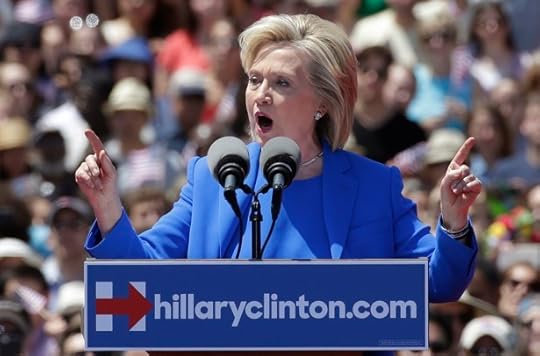
NEW YORK—After Hillary Clinton's speech, as the spectators began to file out from the sun-drenched island park, I came across an elderly couple arguing about it.
“I thought it lacked energy,” said 71-year-old Susanne Ellman.
“I was energized, Susanne,” said her husband, 73-year-old Marty Ellman. The Ellmans are retired from IBM and volunteered full-time on both of President Obama's presidential campaigns.
Clinton would make a fine president, but she was not charismatic, Susanne fretted. Her candidacy wouldn’t excite people.
“She covered all the bases I cared about. She had very solid proposals,” Marty countered. He especially liked Clinton's support for a constitutional amendment to, as he put it, “prevent corporations from buying elections.”
“All I heard was a lot of things she'll never be able to get done!” cried Susanne.
“She's going to fight the good fight!” Marty replied. “That's the important part.”
The Ellmans were both right: In her 45-minute address on New York's Roosevelt Island, a wooded sliver in the East River between Manhattan and Queens, Clinton laid out many proposals that Democrats care about. She did so in a speech that was almost aggressively pedestrian, devoid of soaring rhetoric or big ideas. “America can't succeed unless you succeed,” she said. “That's why I am running for president of the United States.” Clinton’s entire candidacy, it seemed, was built around a non sequitur.
The occasion itself was a strange one. Saturday's speech was, according to Clinton's campaign, a “launch,” yet Clinton announced her candidacy two months ago. Was she hoping to start over? Certainly not, her staff insisted—everything, they say, is going just fine, terrifically even. The chairman of Clinton's campaign, John Podesta, resorted to a baseball metaphor to explain the double beginning: “We've had spring training,” he said. “Now it's opening day.”
Saturday's speech was quite substantive and quite liberal. It was also quite flat.Since declaring herself a candidate in April, Clinton has puttered along—making discreet forays into Iowa and New Hampshire, appearing at a smattering of fundraisers. She has taken stands, selectively, on hot-button issues, notably immigration, criminal justice, and voting rights—in all three cases, articulating meaty, liberal policy stances—while avoiding wading into issues that have badly divided her party, like free trade or the prospect of escalating intervention in the Middle East. She has studiously ignored or waved off the swirling controversies about her use of email and the finances of the Clinton Foundation. She has listened.
In keeping with the campaign so far, Saturday's speech was quite substantive and quite liberal. It was also quite flat. Clinton read it slowly off the teleprompter, articulating every word, sometimes with odd emphasis, in a near-monotone. Clinton spoke in Four Freedoms Park, a locale chosen for its symbolic freight. It was a surprisingly small venue that did not quite fill up; an area set up for overflow with a large TV screen remained vacant. The campaign said more than 5,500 people were in attendance.
Clinton began with a tribute to Roosevelt's “four freedoms,” though she never said what they were. She segued into what she called her “four fights”: to make the economy work for the middle class; to strengthen America's families with pro-worker policies; to “maintain our leadership for peace, security and prosperity”; and to reform government and revitalize democracy. Under these vague headings she crammed expanding renewable energy, fighting climate change, funding infrastructure, universal preschool and childcare, making college affordable, paid sick days, paid family leave, equal pay for women, services for the addicted and mentally ill, a path to citizenship for undocumented immigrants, a ban on discrimination against gay and transgender people, and automatic voter registration.
No one could accuse Clinton of not having an agenda; none of the Republican candidates has offered such a barrage of proposals.The national-security section of the speech was optimistic, but exceedingly vague, with talk of meeting emerging threats with “creative and confident leadership.” Clinton summed up her accomplishments as secretary of state this way: “I’ve stood up to adversaries like Putin and reinforced allies like Israel. I was in the Situation Room on the day we got bin Laden.” Other than a vow to “rein in banks that are still too risky,” Clinton did not inveigh against the rich and powerful. Yet no one could accuse Clinton of not having an agenda; none of the Republican candidates has offered such a barrage of proposals. Recent polls have shown that most voters do not find Clinton trustworthy. She is apparently betting that policy and substance can be a substitute for character and personality.
For the most part, Clinton’s was a speech that could have been given, with very little modification, by almost any Democratic Senate candidate. There was hard-luck story by proxy, in this case her mother's abandonment at the hands of Clinton's grandparents. There was the invocation of the American spirit (resilience, determination). There were paeans to small businesses and the importance of family. An accusation that Republicans belong to the past, delivered as an excruciatingly corny riff on the Beatles (“They believe in yesterday!”). “It's America's basic bargain: If you do your part, you ought to be able to get ahead,” said Clinton and seemingly every other candidate you've ever heard give a speech.
There was a token attempt to make a personal connection. Clinton spoke about her mother’s difficult beginning, neglected by her family and working as a housemaid from the age of 14. Clinton talked about volunteering, through her church, to babysit the children of Mexican farmworkers, and knocking on doors for the Children's Defense Fund to find children whose disabilities prevented them from going to school. “I may not be the youngest candidate in this race,” she said, “but I will be the youngest woman president in the history of the United States! And the first grandmother as well.”
The crowd, which skewed young, diverse, and polite, gave this line a cheer. They waved little American flags and held up their phones to take pictures and videos. Clinton will spend the coming week visiting Iowa, New Hampshire, South Carolina, and Nevada, and will proceed to flesh out her vision with policy speeches, delivered approximately weekly until the end of the summer.
“She's doing exceptionally well—in a one-man race.”Clinton’s advisers worry about the lack of passion the candidate elicits, but Saturday's speech was so non-rousing as to make one wonder whether that wasn't intentional—was it an attempt to bring Clinton down to earth, to make her ordinary? To deflate the aura of fame that clings to her and turn her into just another candidate, one who is solid and sensible and not too flashy, with lots of concrete plans?
Clinton tried this tack before, in 2008, when she tried in vain to convince Democratic voters that Barack Obama was all style and no substance. But this time, she is hoping she won't have that kind of competition. On my way into Saturday's rally, I ran into Charlie Rangel, the scandal-ridden Harlem representative, still going strong at 85. I asked him how he thought Hillary's campaign was going, and he laughed.
“Well, who's she competing against?” he said. Technically, there are three other declared Democratic candidates, but Clinton leads them in the polls by an average of 48 percentage points. Rangel said he did not know anyone who regarded them as real competition to Clinton. “She's doing exceptionally well,” Rangel said, “in a one-man race.”









Hillary Announces Her Agenda

NEW YORK—After Hillary Clinton's speech, as the spectators began to file out from the sun-drenched island park, I came across an elderly couple arguing about it.
“I thought it lacked energy,” said 71-year-old Susanne Ellman.
“I was energized, Susanne,” said her husband, 73-year-old Marty Ellman. The Ellmans are retired from IBM and volunteered full-time on both of President Obama's presidential campaigns.
Clinton would make a fine president, but she was not charismatic, Susanne fretted. Her candidacy wouldn’t excite people.
“She covered all the bases I cared about. She had very solid proposals,” Marty countered. He especially liked Clinton's support for a constitutional amendment to, as he put it, “prevent corporations from buying elections.”
“All I heard was a lot of things she'll never be able to get done!” cried Susanne.
“She's going to fight the good fight!” Marty replied. “That's the important part.”
The Ellmans were both right: In her 45-minute address on New York's Roosevelt Island, a wooded sliver in the East River between Manhattan and Queens, Clinton laid out many proposals that Democrats care about. She did so in a speech that was almost aggressively pedestrian, devoid of soaring rhetoric or big ideas. “America can't succeed unless you succeed,” she said. “That's why I am running for president of the United States.” Clinton’s entire candidacy, it seemed, was built around a non sequitur.
The occasion itself was a strange one. Saturday's speech was, according to Clinton's campaign, a “launch,” yet Clinton announced her candidacy two months ago. Was she hoping to start over? Certainly not, her staff insisted—everything, they say, is going just fine, terrifically even. The chairman of Clinton's campaign, John Podesta, resorted to a baseball metaphor to explain the double beginning: “We've had spring training,” he said. “Now it's opening day.”
Saturday's speech was quite substantive and quite liberal. It was also quite flat.Since declaring herself a candidate in April, Clinton has puttered along—making discreet forays into Iowa and New Hampshire, appearing at a smattering of fundraisers. She has taken stands, selectively, on hot-button issues, notably immigration, criminal justice, and voting rights—in all three cases, articulating meaty, liberal policy stances—while avoiding wading into issues that have badly divided her party, like free trade or the prospect of escalating intervention in the Middle East. She has studiously ignored or waved off the swirling controversies about her use of email and the finances of the Clinton Foundation. She has listened.
In keeping with the campaign so far, Saturday's speech was quite substantive and quite liberal. It was also quite flat. Clinton read it slowly off the teleprompter, articulating every word, sometimes with odd emphasis, in a near-monotone. Clinton spoke in Four Freedoms Park, a locale chosen for its symbolic freight. It was a surprisingly small venue that did not quite fill up; an area set up for overflow with a large TV screen remained vacant. The campaign said more than 5,500 people were in attendance.
Clinton began with a tribute to Roosevelt's “four freedoms,” though she never said what they were. She segued into what she called her “four fights”: to make the economy work for the middle class; to strengthen America's families with pro-worker policies; to “maintain our leadership for peace, security and prosperity”; and to reform government and revitalize democracy. Under these vague headings she crammed expanding renewable energy, fighting climate change, funding infrastructure, universal preschool and childcare, making college affordable, paid sick days, paid family leave, equal pay for women, services for the addicted and mentally ill, a path to citizenship for undocumented immigrants, a ban on discrimination against gay and transgender people, and automatic voter registration.
No one could accuse Clinton of not having an agenda; none of the Republican candidates has offered such a barrage of proposals.The national-security section of the speech was optimistic, but exceedingly vague, with talk of meeting emerging threats with “creative and confident leadership.” Clinton summed up her accomplishments as secretary of state this way: “I’ve stood up to adversaries like Putin and reinforced allies like Israel. I was in the Situation Room on the day we got bin Laden.” Other than a vow to “rein in banks that are still too risky,” Clinton did not inveigh against the rich and powerful. Yet no one could accuse Clinton of not having an agenda; none of the Republican candidates has offered such a barrage of proposals. Recent polls have shown that most voters do not find Clinton trustworthy. She is apparently betting that policy and substance can be a substitute for character and personality.
For the most part, Clinton’s was a speech that could have been given, with very little modification, by almost any Democratic Senate candidate. There was hard-luck story by proxy, in this case her mother's abandonment at the hands of Clinton's grandparents. There was the invocation of the American spirit (resilience, determination). There were paeans to small businesses and the importance of family. An accusation that Republicans belong to the past, delivered as an excruciatingly corny riff on the Beatles (“They believe in yesterday!”). “It's America's basic bargain: If you do your part, you ought to be able to get ahead,” said Clinton and seemingly every other candidate you've ever heard give a speech.
There was a token attempt to make a personal connection. Clinton spoke about her mother’s difficult beginning, neglected by her family and working as a housemaid from the age of 14. Clinton talked about volunteering, through her church, to babysit the children of Mexican farmworkers, and knocking on doors for the Children's Defense Fund to find children whose disabilities prevented them from going to school. “I may not be the youngest candidate in this race,” she said, “but I will be the youngest woman president in the history of the United States! And the first grandmother as well.”
The crowd, which skewed young, diverse, and polite, gave this line a cheer. They waved little American flags and held up their phones to take pictures and videos. Clinton will spend the coming week visiting Iowa, New Hampshire, South Carolina, and Nevada, and will proceed to flesh out her vision with policy speeches, delivered approximately weekly until the end of the summer.
“She's doing exceptionally well—in a one-man race.”Clinton’s advisers worry about the lack of passion the candidate elicits, but Saturday's speech was so non-rousing as to make one wonder whether that wasn't intentional—was it an attempt to bring Clinton down to earth, to make her ordinary? To deflate the aura of fame that clings to her and turn her into just another candidate, one who is solid and sensible and not too flashy, with lots of concrete plans?
Clinton tried this tack before, in 2008, when she tried in vain to convince Democratic voters that Barack Obama was all style and no substance. But this time, she is hoping she won't have that kind of competition. On my way into Saturday's rally, I ran into Charlie Rangel, the scandal-ridden Harlem representative, still going strong at 85. I asked him how he thought Hillary's campaign was going, and he laughed.
“Well, who's she competing against?” he said. Technically, there are three other declared Democratic candidates, but Clinton leads them in the polls by an average of 48 percentage points. Rangel said he did not know anyone who regarded them as real competition to Clinton. “She's doing exceptionally well,” Rangel said, “in a one-man race.”









The Hacking of Federal Data Is Much Worse Than It First Seemed

To truly understand just how rigorous and intrusive the process to get security clearance for the federal government is, take a look a Standard Form 86.
Formally known as the Questionnaire for National Security Positions, the document requires that an applicant disclose everything from mental illnesses, financial interests, and bankruptcy issues to any brush with the law and major or minor drug and alcohol use. The application also requires a thorough listing of an applicant’s family members, associates, or former roommates. At the bottom of each page, a potential employee must submit his or her social security number. Given the questionnaire’s length, that means if you’re filling out this document, you will write your social security number over 115 times.
On Friday, it was revealed that all of the data on Standard Form 86— filled out by millions of current and former military and intelligence workers— is now believed to be in the hands of Chinese hackers.
This not only means that the hackers may have troves of personal data about Americans with highly sensitive jobs, but also that contacts or family members of American intelligence employees living abroad could potentially be targeted for coercion. At its worst, this cyberbreach also provides a basic roster of every American with a security clearance.
"That makes it very hard for any of those people to function as an intelligence officer,” Joel Brenner, a former top U.S. counterintelligence official, told the AP. “The database also tells the Chinese an enormous amount of information about almost everyone with a security clearance. That's a gold mine. It helps you approach and recruit spies."
What’s particularly stunning about this development is how quickly it grew into something so severe. Last week, officials estimated that the personal data of 4 million current and former federal employees had been compromised. Then that figure ballooned to as many as 14 million.
Speaking to The Washington Post, one official ominously likened this new revelation to cancer, “Once you start operating on the cancer, you find it has spread to other areas of the body.” The subtext here is that we may not have even hit the apex of this scandal yet.
In the meantime, China continues to deny that it stole the information and the U.S. Office of Personnel Management isn’t saying much either. “Once we have conclusive information about the breach, we will announce a notification plan for individuals whose information is determined to have been compromised,” said OPM spokesman Samuel Schumach.
Given the reach of the data thought to be stolen, it might be easier for the OPM to contact those whose information hasn’t been compromised.









An Attack on Dallas Police Headquarters

Updated at 3:44 p.m.
Officials have confirmed that the man who fired at a Dallas police building on Saturday morning was killed by a police sniper after an hours-long standoff. Dallas Police Chief David Brown added that police believe the suspect acted alone in the attack.
While officials still haven’t confirmed the suspect’s identity—the man told officers his name was James Boulware—NBC News caught up with Boulware’s mother who said that her son suffered from mental illness and had a history of violence.
The family also confirmed his death in a statement released on Saturday. "We tried to get him mental help numerous times, but the system failed him, because he was declared 'sane.' He was very delusional. It was very obvious."
Updated at 10:50 a.m.
The suspect involved in the shooting at a police headquarters in Dallas is believed to have been killed after snipers opened fire on his van on Saturday morning.
Police Chief David Brown told reporters that the standoff ended after police shooters fired on the van and struck the suspect. The man, who claimed to have explosives in his vehicle, has yet to be identified by authorities.
According to The Los Angeles Times, investigators believe the man acted alone, despite eyewitness accounts that suggest multiple people participated in the attack.
“We are blessed that our officers were not injured,” Brown told reporters, nothing that police officers and staffers had been in the line of fire when the assault took place.
Very little is known about an attack on police headquarters in south Dallas early on Saturday morning. According to reports, one gunman (or perhaps multiple gunmen) opened fire on the building with automatic weapons shortly after midnight.
Dallas Police Chief David Brown told reporters that explosives were also found outside the headquarters. While no injuries have been reported and no motive has been established, a standoff between police and a shooter in an armored van continues in a parking lot.
What We Know About the Shooting
The attack took place in an affluent section of the Texas city, where at least one shooter struck building windows and police car windshields with bullets before taking off in a van. The van also rammed into multiple police cars.
CNN is reporting multiple exchanges of gunfire between police officers and the shooter (or shooters) not only at the police headquarters, but at a second site, the parking lot of a suburban Jack in the Box restaurant, where a standoff is underway. According to Reuters, at least two explosive devices were found outside the building, one of which exploded when a police robot tried to move it.
What We Know About the Shooter
While only one shooter has been confirmed, witnesses say as many as four gunmen participated in Saturday’s attack. Police have noted there are conflicting accounts.
Relaying word from Dallas Police Chief David Brown, the AP wrote that “the suspect driving the van has told officers that he blames police for losing custody of his son and ‘accusing him of being a terrorist.’” The man also claims to have more explosives in his armored van, which is outfitted with gun ports.
Reuters reports that the suspect has identified himself as James Boulware, but his identity has yet to be confirmed.









Atlantic Monthly Contributors's Blog
- Atlantic Monthly Contributors's profile
- 1 follower



